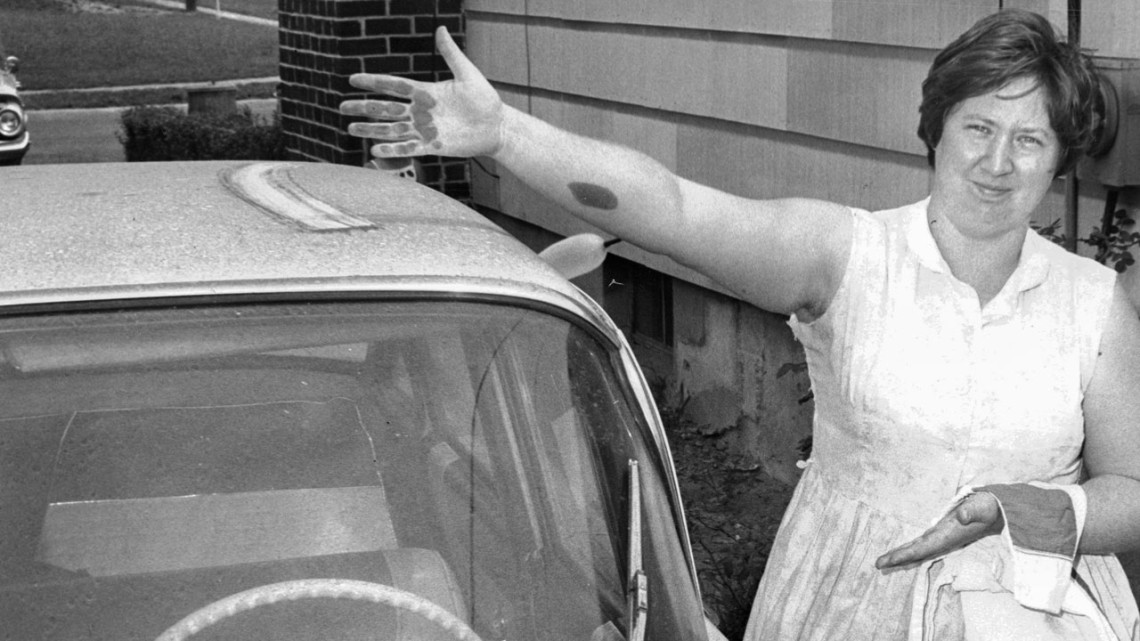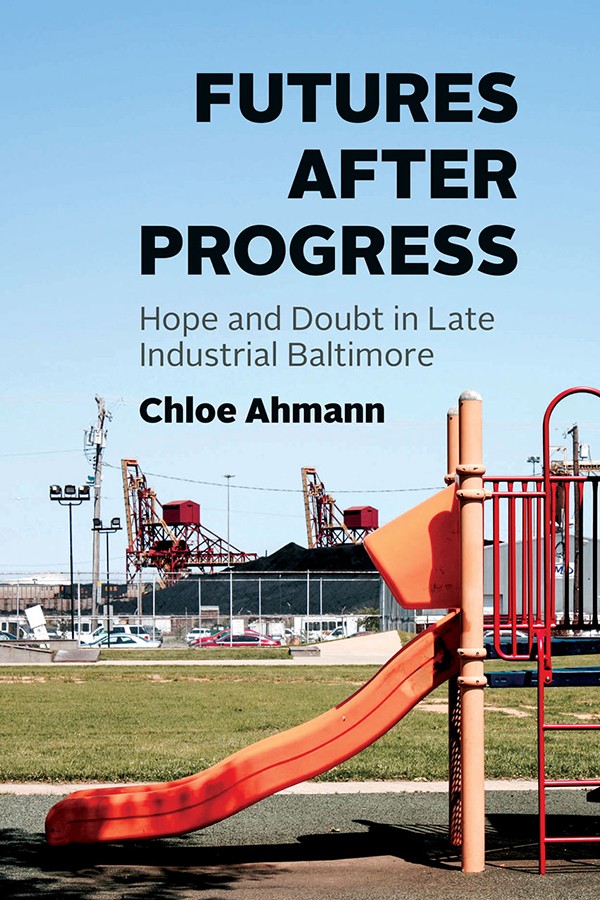
A Baltimore woman wipes soot from the roof of her car in a photo dated July 8, 1967.
Beyond the ‘booms’: Book probes everyday disasters in South Baltimore, offers hope
By James Dean, Cornell Chronicle
On South Baltimore’s Curtis Bay peninsula, not far from the Francis Scott Key Bridge, homes overlook a 14-million-ton capacity coal export terminal that is the nation’s second largest. Residents say its giant, open-air coal piles disperse a fine dust that coats the neighborhood, even turns the lungs of area crabs black – and that those piles have grown since the bridge’s collapse in March.
Maryland native Chloe Ahmann, assistant professor of anthropology in the College of Arts and Sciences, got to know Curtis Bay while working there as an elementary school teacher after college. She saw children skip recess because they had trouble breathing, and learned about a proposal to construct another noxious project near their homes – the nation’s largest trash incinerator, touted as a renewable energy project.
Ahmann would go on to spend more than a decade conducting ethnographic and historical research in the multiracial, working-class community, documenting its industrial past and deeply uncertain futures in a moment marked by both pollution and the loss of steady work. She argues these twin losses have ushered in a present “after progress.”
“[Curtis Bay] has quite literally built the American dreamscape, even as so few here get to live that dreamscape out,” Ahmann writes in her new book, “Futures after Progress: Hope and Doubt in Late Industrial Baltimore.” “If we want to grasp the creeping, cryptic fullness of the problems industrial capitalism has left us all to grapple with, it is precisely the kind of place that should be at the center of our vision.”
But Curtis Bay is not only a site of violence, and Ahmann also followed local efforts to make lives worth living in its midst. She discussed her research with the Chronicle.
Question: How did the Key Bridge crisis affect Curtis Bay?
Answer: The Key Bridge collapse has stopped all sorts of exports from leaving the Port of Baltimore. Those exports include coal, which means that the coal piles locals have long lived with have been growing rapidly. Dust from those piles escapes and covers every surface – cars, clotheslines, stoops, slides, even children’s bicycles. That dust is a tangible reminder that spectacular disasters like the bridge collapse can’t be uncoupled from mundane violence, like toxicity. As a city, state and nation, we err deeply when we simply pay attention to the “booms”– gunfire, infrastructural collapse, chemical spills, even plant explosions – and not the everyday disasters that characterize life with industry.
Q. Gun violence has dominated political debates, news coverage and popular culture depictions of Baltimore. Why did you focus instead on industrial and environmental issues?
A. There’s so much spectacularized writing on violence in Baltimore – to say nothing of its portrayal in the news – and this pathologizes people in the city. Gun violence matters, of course, but it’s simply incorrect that it’s the primary cause of death in Baltimore. Researchers have found that deaths attributable to long-term air pollution are four times the number caused by homicide. These deaths can be prevented. In my book, I center this reality.
Q. Is Curtis Bay similar to post-industrial communities across the country?
A. Yes, in many ways. But this site’s unique importance to securing urban, national and corporate futures cannot be overstated. When immigrants flocked to the 19th century city, it served as a quarantine zone where public health officials separated sickly foreign bodies from the downtown population. Later, workers here built ships and stockpiled weapons to provision two world wars. More recently, it’s become a corporatized industrial zone that hosts chemical production, fuel transport and much of the city’s waste. When people wipe dust from their stoops to sit and chat – a ritual with which the book begins – they make contact with these histories, and with elsewheres all around the world that this place serves. After more than a decade working on these matters, I’m still in awe of that. It means that there’s no telling the story of this small peninsula without telling a series of much bigger stories: of Baltimore City, of American Empire, of the multinational corporation.
Q. Why was it so significant when a company chose Curtis Bay for its incinerator project – ultimately defeated in 2016 by a student-led opposition?
A. The “Fairfield Renewable Energy Project” – a euphemism if there ever was – would have been the largest trash incinerator in the nation. And if that weren’t insult enough, it was also billed as a green technology, on part with wind and solar, and incentivized by the state. Both these things make it important. But what particularly drew me in was how students organized against it: not as an isolated imposition, but as indicative of toxic trends that have long shaped their neighborhood. Youth organizers fought the project on the grounds this place had basically had enough. At the same time, some local elders hoped the project would succeed, even revive an industrial past they’d watched disintegrate. In the midst of all of this, the Fairfield Project came to stand for much more than itself, and that’s another thing that makes it so significant. It became an invitation for examining the local past and imagining the future of this place.
Q. Is a more hopeful future emerging?
A. Youth activists won the fight against the Fairfield Project and have since moved onto bigger structural problems, like the state laws that classed it as “renewable” and the broader lack of cumulative (toxic) impacts legislation. They’ve also been building. A few years back, in partnership with other allies, they started the South Baltimore Community Land Trust, which couples environmental justice work with housing justice work, under the banner of “development without displacement.” Their work gives me reasons to be hopeful.
Q. What other lessons do Curtis Bay and South Baltimore offer?
A. One banner takeaway from my research that post-industrial landscapes like South Baltimore are not emblems of the past, not paragons of some lost time that the rest of us have moved beyond. That’s a common way of portraying Rust Belt cities, and it’s both damaging and wrong. They’re better understood as sites where people are engaged in the persistent work of making lives worth living at the end of prior certainties. In a present marked by profound economic and environmental change, they may well foreshadow radically shared futures. We have a lot to learn from them.
Media Contact
Abby Kozlowski
Get Cornell news delivered right to your inbox.
Subscribe

